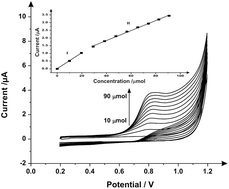Electroanalytical detection of pindolol: comparison of unmodified and reduced graphene oxide modified screen-printed graphite electrodes†
Abstract
Recent work has reported the first electroanalytical detection of pindolol using reduced graphene oxide (RGO) modified glassy carbon electrodes [S. Smarzewska and W. Ciesielski, Anal. Methods, 2014, 6, 5038] where it was reported that the use of RGO provided significant improvements in the electroanalytical signal in comparison to a bare (unmodified) glassy carbon electrode. We demonstrate, for the first time, that the electroanalytical quantification of pindolol is actually possible using bare (unmodified) screen-printed graphite electrodes (SPEs). This paper addresses the electroanalytical determination of pindolol utilising RGO modified SPEs. Surprisingly, it is found that bare (unmodified) SPEs provide superior electrochemical signatures over that of RGO modified SPEs. Consequently the electroanalytical sensing of pindolol is explored at bare unmodified SPEs where a linear range between 0.1 μM–10.0 μM is found to be possible whilst offering a limit of detection (3σ) corresponding to 0.097 μM. This provides a convenient yet analytically sensitive method for sensing pindolol. The optimised electroanalytical protocol using the unmodified SPEs, which requires no pre-treatment (electrode polishing) or electrode modification step (such as with the use of RGO), was then further applied to the determination of pindolol in urine samples. This work demonstrates that the use of RGO modified SPEs have no significant benefits when compared to the bare (unmodified) alternative and that the RGO free electrode surface can provide electro-analytically useful performances.


 Please wait while we load your content...
Please wait while we load your content...